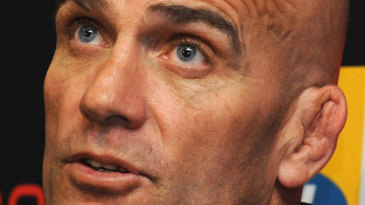
- Feature:
-
'The best drivers since the the late 60s and early 70s'
- News:
-
Schumacher wrong to return, says Stewart
- Drivers:
- François Cevert
- |
- Graham Hill
- |
- Jackie Stewart
There is little you can't research or read about Sir Jackie Stewart's magnificent career. Between his countless interviews and his in-depth autobiography, every facet of his life - from his dyslexia to his driving - has been documented in minute detail.
However, anyone who is lucky enough to get their hands on one of the 1500 limited edition copies of Collage: Jackie Stewart's Grand Prix Album (and they will be lucky as it costs a whopping £295) will find, in many ways, a more personal account of his life than has ever been published before. Constructed from 17 scrapbooks lovingly kept by his wife Lady Helen, Collage is a first-hand trip down memory lane made up of press clippings, family photos and Stewart's own commentary on each major event of his career.
The pages are facsimiles of Helen's carefully glued scrapbooks, appropriately hand-bound by the publishers and signed by Stewart. The story starts in 1955 with photos collected by Stewart's mother of her son starting out on a promising shooting career. It quickly leaps forward to the more familiar images of Stewart behind the wheel of his early racing cars and articles from Scottish newspapers documenting his rise.
As the pages turn the years roll by, and with it the photos become more plentiful and the press clippings more revealing. It is remarkable just how family-based the stories are and how readers of the British tabloids in the 1960s were treated to both race reports and family-based interviews, as Helen became something of a celebrity in her own right. Typically for the time, many of the reports are based around the dangers of the sport and x-rays and photos from hospitals bring home just how perilous an occupation being a Formula One driver was.
In his commentary about his accident at the 1966 Belgian Grand Prix, Stewart recalls how he was saved by his BRM team-mate Graham Hill and Bob Bondurant: "Graham was the first to reach me. I remember he said I was looking 'very second hand'. Then Bob joined him. Bob had turned his car upside down but, apart from dribbling a little blood, he was fine ... They carried me into a barn and put me into the back of a hay truck, naked. My clothing was saturated with high octane fuel which would burn your skin, so I got Graham to take my clothes off. Then these nuns came in, spotted a naked man in the back of a hay truck and tried to put my clothes back on. Having found an ambulance, Graham returned and promptly took all my clothes back off again."
The story shows a glimpse of the kind of camaraderie between drivers in that era, and their bond - along with Graham Hill removing clothes - becomes a common theme in the book, with pictures of drunken parties and behind-the-scenes snaps of the paddock. As he started to become more famous and influential, the death of many of his close friends encouraged Stewart to act on safety. As you delve further into the book there are remarkable examples of the kind of opposition he faced, even trying to pass the sort of measures all current F1 drivers take for granted.
"There is little, if anything, in motor racing today for which I can thank Stewart," reads a letter from a reader of Motor Sport at the time. "I have enjoyed the motor racing scene less and less since he arrived rattling his money box and waving his petitions. It appears he is unable to distinguish between commercialism and professionalism, but he is not alone. In today's competitive motoring, standards of the code of conduct of some of the better known racers borders on the football management mentality and the semi-illiterate soccer 'stars' ... To change the rules, to make it all safe and cosy, to complain about the risks in one's chosen profession and then to demand more and more reward is just cheating."

"The reality of my time as a driver - and the finality of death - was rammed home with the cruellest blow when Francois was taken," writes Stewart. "Death constantly rode on our shoulders, but to lose Francois on what was to be the final weekend of my racing career... There couldn't have been anything more hurtful outside the loss of my own family. I had enjoyed all the rewards and accolades of Formula One, but at Watkins Glen in 1973 I saw its darkest, most unattractive side."
Stewart's honesty brilliantly matches the scrambled together page layouts, to create a real insight into life as an F1 driver in the 1960s and 1970s. With so little footage of that era in circulation, Collage is also a fascinating historical account of Stewart's life and career for those who weren't lucky enough to witness it firsthand. The biggest shame is that the limited printing means that only those with £295 to blow on one book will be able to appreciate it.

Title: Collage: Jackie Stewart Grand Prix Album
Published by: Genesis Publications
Price: £295
The book is availible to buy at Genesis Publications' website or by phoning +44(0)1483 540 970.
Laurence Edmondson is an assistant editor on ESPNF1
© ESPN Sports Media Ltd.
 Laurence Edmondson is deputy editor of ESPNF1 Laurence Edmondson grew up on a Sunday afternoon diet of Ayrton Senna and Nigel Mansell and first stepped in the paddock as a Bridgestone competition finalist in 2005. He worked for ITV-F1 after graduating from university and has been ESPNF1's deputy editor since 2010
Laurence Edmondson is deputy editor of ESPNF1 Laurence Edmondson grew up on a Sunday afternoon diet of Ayrton Senna and Nigel Mansell and first stepped in the paddock as a Bridgestone competition finalist in 2005. He worked for ITV-F1 after graduating from university and has been ESPNF1's deputy editor since 2010

